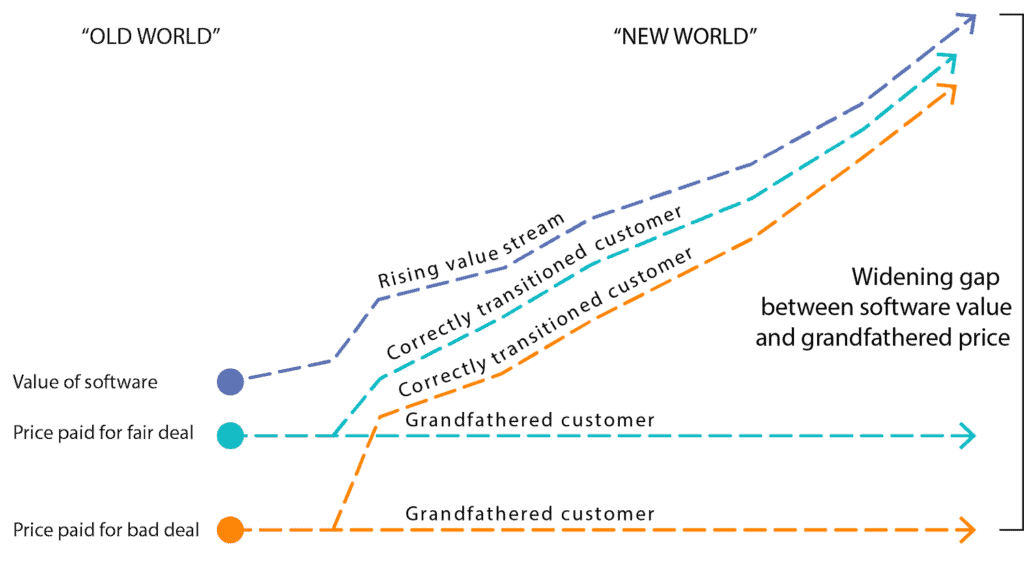This widespread practice greatly increases pricing risk by giving away revenue
In this second blog in our series on the risks of changing software pricing, I’ll focus on a very risky pricing practice: grandfathered pricing. Grandfathered pricing allows existing customers to retain their current payment structure when you change pricing for new customers (you know the old adage, “just water under the bridge”).
Using grandfathered pricing might seem like a good way to protect customer relationships and maintain recurring support and maintenance revenue during transitions. But there are much better ways of taking care of customers when introducing substantial change. These Market Fairness Pricing techniques revolve around the five best practices I share in this blog.
These best practices avoid the main problem with grandfathered pricing, which is that it gives away software value. Often grandfathered customers are granted access to a new version of the software, with additional capabilities, without having to pay for the privilege. They may have bought at a time in the company’s history when they received an enormous discount for a product that delivered a fraction of the value of its current feature set. As a result, using grandfathered pricing with early customers usually reduces both transitional and future revenue streams.
The impacts of grandfathered pricing with early customers using old pricing structures:
Transitional revenues. When you grandfather, you lose the opportunity to increase revenue from existing customers. Market Fairness Pricing, in contrast, seeks to upgrade customers to a new offer providing them with additional value. When raising prices, as long as you help customers understand the added value, most will be okay with paying a fair price for it. The revenue uplift from this realignment of price to value can help you weather the monetary rockiness of making transitions—for example, from on-prem to cloud pricing models.
Future revenues. When you grandfather, allowing customers to pay the same price point, you throw away your (perhaps last) opportunity to correct pricing mistakes from the original sale. Bad deals from the “old world”—which have allowed customers to egregiously overuse software without paying fairly for its value—are moved right into the “new world.” Once that happens, the lack of parity between value and price only worsens. These customers are forever anchored in the unfair price they paid years ago, which jeopardizes your annuity stream going forward, in perpetuity. Without a reset, such as upgrading the customer to a new product offering, you’re stuck.
Top five best practices for transitioning existing customers to a new pricing plan
Here are key Market Fairness Pricing techniques for keeping existing customers happy while increasing revenues rather than giving them away:
1. Upgrade legacy customers to a new offer.
Don’t ask customers to pay more for the same software—and don’t give away new software capabilities. Present the transition as an upgrade opportunity, and be sure you’re offering something they’ll consider worth paying a little more. For example, if you’re upgrading customers from on-prem to cloud software, they’re gaining access to your latest software and a stream of future upgrades. While a certain enhancement rate is implicit in the subscription, that is very different from granting all value carte blanche, which is what you do with grandfathered pricing tactics. No software product lasts forever, of course. (Typical architectures emerge and dominate for a decade or so. The current shift to serverless architectures is an example.)
In Market Fairness Pricing—which emphasizes fairness to customers and software companies—significant software changes, such as a new architecture or radically innovative UI, naturally come with price increases.
2. Use packaging levers to create a value difference.
By getting innovative with packaging, you can provide customers with an appealing upgrade path that makes sense for them. To do that successfully, segment your customer base into “classes” that similarly use and derive value from your software. Based on invoice, usage, transactional data and qualitative inputs, this process differs from traditional market segmentation by criteria such as organization size and geography.
It’s also very different from the buying personas commonly used to drive content, attract leads and isolate roles inside the sales process. Remember that software purchases, especially in enterprise sales, are often made by buyers who may never use the software themselves.

3. Model transactional and usage data to forecast “old world” to “new world” revenue impacts.
Modern tools (such as our LevelSetter) analyze the real-world data described in #2 so you can anticipate and measure the probable results of making changes to your pricing model and packaging. They enable you to explore what-if scenarios and present simulations to stakeholders and executive teams. Use them to plan and structure sophisticated deployment programs that mitigate risk and dynamically adjust pricing plans and packaging to diverse requirements in full-scale rollouts.
4. Prepare salesforce to discuss old world/new world value shifts and comparisons with customers.
Make sure your new pricing model is simple and easy to understand. Then train your salesforce to explain the rationale behind the pricing model, show how it scales and defend its integrity under questioning. This is what we call pricing fluency—the ability to tour prospects through how your pricing works.
For example, in LevelSetter, salespeople can see their quotes and quickly isolate the preferred pricing fluency for their buyers (such as discount percent, per-unit pricing, monthly vs. annual, growth and expansion scenarios). Salespeople fluent in pricing have the confidence and agility to come up with relevant examples and accurately answer customer “what if?” questions on the fly. (And oh, by the way, salespeople are always more fluent when they understand and are on board with how sales compensation structures change with the new pricing model.)
5. Give customers the time they need to transition.
Depending on the availability of software features they value and the time it’s going to take to prepare their internal processes for change, customers will require varying amounts of time to make the transition. For this reason, we often recommend matrixing another layer of segmentation on top of the usage/value customer classes described in #2. It can help you set realistic time-to-new-world expectations and craft tailored transition strategies.
Learn more about reducing your software pricing risks
Now you understand that there are better methods and strategies than using grandfathered pricing. To learn more about reducing your risk when making software pricing changes, download our ebook on Transitioning to SaaS Revenue and watch for more blogs in this series.




